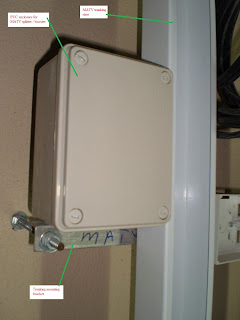Picture 1 - MATV trunking riser
(Click on the image to enlarge it)
================= RELATED ARTICLES: Underfloor trunking below structural rebars | MATV antenna bracket pictures | Lighting flexible conduits | Conduit to trunking connections | Cable ladder pictures | Electrical conduits and trunking pictures | Electrical panel under water pipes | Electrical busduct installation pictures | Electric conduit installation pictures | FR electric cable installation pictures | Underfloor trunking pictures | Site-fabricated electrical trunking | Electrical Services Color Codes
===========
Location: Inside the ELV riser
TYpe of building: Office building
Other description:
MATV is an acronym of Master Antenna Television. Nowadays this name is often changed to SMATV, with the letter S added to show that the system can also receive the satellite with just the addition of a satellite dish antenna and a suitable head-end amplifier module.
No other additional parts are needed.
Even though the vertical distribution of the television signal is carried from top or roof of the building downward, it is quite common to call the vertical MATV cabling as the riser cable.
The vertical cables are actually down-feed cables, similar to the distribution of the drinking water supply from water storage tank mounted at the roof a a building.
The water is then fed to individual floors through one or more "main cold water riser pipes".
For electrical cables, it is more common to run vertical main cables on trays.
When trunking are used in ways similar to the MATV trunking is the above picture, they usually are used to carry wiring cables, not the vertical distribution cables.
I guess it is just easir to handle and manage the small wiring cables if the steel trunking is used.
But when the main vertical cables are involved, cable trays are the preferred method most of the time.
Notice also I have marked the enclosure that has been used to mount accesories for the distribution of the TV signals. Things such as the signal boosters, the splitters, etc.
Having the accessories mounted inside the riser next to the riser trunking is not just for the ease of cable connection, but also for the protection of these accessories from damage, theft and vandalism.
This may sound trivial sometimes, but in some buildings these issues are ongoing major problems.
I have also zoomed in to the mounting bracket for the trunking riser as shown in the following picture:
Picture 2 - The mounting bracket for the MATV riser trunking
(Click on the image to enlarge it)
Observe how a set of screw stud is used with a few nut and washers to provide a reliable and easy to implement mounting method for the vertical trunking.
Notice also how the angle iron is extended at this location to provide a nice mounting base for the PVC enclosure.
Copyright http://electricalinstallationwiringpicture.blogspot.com/ MATV trunking riser










